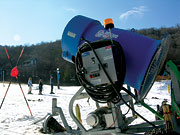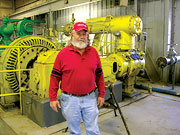
Blow hard: A traditional air-and-water “cannon,” ready to make some flakes. photos by Melissa Cain Smith
|
Natural snow is created from the water vapor that hovers around in the atmosphere. Cooling temperatures cause the vapor to condense and form clouds. Dirt and other drifting particles offer a nucleus that water molecules can cohere to. When the air is cold enough, the vapor freezes, creating crystals that fall to the earth as snow.
As you know, here in Western North Carolina we’re not blessed with an abundance of the white powdery stuff that, supposedly, is characteristic of mountain winters. Our mild winters, with unseasonably warm bouts, present a constant challenge to those who work the ski slopes — people whose livelihood depends on snow. Thankfully for their sake, technology provides the means to produce manmade snow, allowing the slopes to remain open even on the warmest winter days. To get a feel for what happens when Mother Nature fails to sugarcoat our region, I spoke with Wayne Hoilman, president, general manager and snow-maker for Ski Beech, to learn his daily recipe for snow.
Beech Snow

Heavy metal: Ski Beech Manager Wayne Hoilman shows off the resort’s massive air compressor, used for snow-making.
|
Ski Beech is located at the apex of the town of Beech Mountain. At 5,506 feet, the town is hailed as the highest community east of the Rockies. Annual snowfall here amounts to about 80 inches, which may sound impressive, but, according to Hoilman, yields only three days per season of natural snow. When you consider the stakes of operating 90 acres of skiable terrain seven days a week through the winter months — a prospect that takes $5 million just to open for the season — well, let’s just say you’d better be able to produce snow. Enter the snow machines …
If you’ve ever been skiing, you’ve undoubtedly seen these machines blasting snow across the slopes. Machine-made snow is essentially the same as natural snow. Air and water are the basic components, but the process is expedited by using a natural, proprietary protein called Snowmax that serves as the “nucleator” for bonding water molecules.
The type of machines that for years have been used to manufacture snow are “cannons,” running on compressed air and cooled water. Two hoses are attached to the guns; one pumps water in from a nearby source and the other shoots high-pressure air from an air compressor. Together they produce a fine vapor mist, which, with the help of a little Snowmax, cools, freezes and disperses as snow.
A newer, energy-saving, but more costly alternative is the “airless” snow gun. Airless guns produce snow in much the same way as traditional guns, but rather than using expensive compressed air, they run on powerful electric fans. The “airless” claim, then, isn’t completely accurate.
Ski Beech produces snow continuously using 125 traditional air-water cannons and nine airless guns. Six giant air compressors, housed away from the slopes, pump air at 24,500 cubic feet per minute. Five water pumps force 3,200 gallons of water 830 feet up the mountain every minute. In addition to a price tag of $3,000 each for traditional snow-makers and anywhere between $12,000 and $30,000 for airless guns, operating the machines carries a considerable cost.
“The electrical costs of snow-making alone are roughly $500 per hour,” explains Hoilman. “And that’s without the costs of labor, equipment, repairs or insurance.”
A typical day
Operating a ski resort and producing snow is not only expensive, but time consuming as well. Hoilman has worked on the slopes for almost 40 years, acting as the general manager and president of Ski Beech for the past 12. He works seven days a week, averaging about 15 hours per day, November through March. Aside from handling business relations, Wayne is also the head-honcho snow-maker, calling the shots on how and when to make the snow and where to distribute it throughout the slopes. And even during the warmer months, his time is consumed with testing, repairing and updating equipment to prepare for the next season.
Hoilman’s day begins well before sunrise. He arrives at Ski Beech at 5 a.m., has his coffee and completes a snow report, which notifies the Southeastern Ski Areas Association about the number of trails the resort will have open that day and their condition. He then grooms the slopes to get a better feel for where the snow is and isn’t. By 7 a.m., his daytime snow-makers have arrived and been given orders for shifting the snow around.
The balance of Hoilman’s day is spent in his office handling day-to-day business and, of course, keeping an eye on the weather. Around 4 p.m. he grooms the slopes again, makes another set of observations and continues watching the weather before giving instructions to the night-shift snow-makers, who arrive at 7 p.m. His day ends around 8 p.m.
As important as they are, air, water, commitment, pricey equipment, a well-trained staff and a huge budget aren’t the only ingredients for snow production. The head snow-maker must also be a sort of weatherman extraordinaire. Granted, machines do make the snow, but there is a fine science to determining what sort of snow the machines produce: wet and sticky or dry and fluffy. A snow-maker constantly maintains a watchful eye on weather conditions to balance the humidity/temperature ratio and wind speed. Low humidity (around 40 percent) and temperatures in the teens are ideal conditions for maintaining the proper layers of surface snow. Wind direction and speed are also factors, since wind is relied upon to disperse the snow across the slopes. Too much wind can send powdery snow up and over the mountainside, a waste of good money.
So, next time you hit the slopes and are tempted to complain about the handsome sum of money you’ve got to fork over for a fun day of winter sport, consider what goes into the recipe to make it all possible.
[Melissa Smith lives in Asheville.]
Edible Snow
Snow cream is the epitome of a tasty and nostalgic wintertime treat. Here’s a great recipe that’s quick and easy to make — provided it snows.
1-3 cups of snow (make sure it’s not yellow!)
1/2 cup heavy whipping cream or other cream of choice
1 tbs. sugar
2-3 drops vanilla flavoring
In a separate bowl, mix cream, sugar and vanilla. Slowly add snow to desired consistency. Other flavors you might want to try are cinnamon, butterscotch, almond or eggnog mix. Enjoy!


Before you comment
The comments section is here to provide a platform for civil dialogue on the issues we face together as a local community. Xpress is committed to offering this platform for all voices, but when the tone of the discussion gets nasty or strays off topic, we believe many people choose not to participate. Xpress editors are determined to moderate comments to ensure a constructive interchange is maintained. All comments judged not to be in keeping with the spirit of civil discourse will be removed and repeat violators will be banned. See here for our terms of service. Thank you for being part of this effort to promote respectful discussion.